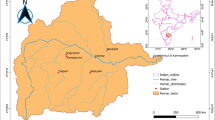Abstract
Although water resources management practices recently use bivariate distribution functions to assess drought severity and its frequency, the lack of systematic measurements is the major hindrance in achieving quantitative results. This study aims to suggest a statistical scheme for the bivariate drought frequency analysis to provide comprehensive and consistent drought severities using observed rainfalls and their uncertainty using synthesized rainfalls. First, this study developed a multi-variate regression model to generate synthetic monthly rainfalls using climate variables as causative variables. The causative variables were generated to preserve their correlations using copula functions. This study then focused on constructing bivariate drought frequency curves using bivariate kernel functions and estimating their confidence intervals from 1,000 likely replica sets of drought frequency curves. The confidence intervals achieved in this study may be useful for making a comprehensive drought management plan through providing feasible ranges of drought severity.











Similar content being viewed by others
References
Adamowski K (1985) Nonparametric kernel estimation of flood frequencies. Water Resour Res 21(11):1585–1590
Bonaccorso B, Cancelliere A, Rossi G (2003) An analytical formulation of return period of drought severity. Stoch Env Res Risk Assess 17(3):157–174
Cancelliere A, Salas JD (2004) Drought length properties for periodic-stochastic hydrologic data. Water Resour Res 40(2):W02503
Chen L, Singh VP, Gui S (2011) Drought analysis based on copulas. 2011 Symposium on data-driven approaches to droughts. Purdue University, West Lafayette
Chung C, Salas JD (2000) Drought occurrence probabilities and risks of dependent hydrologic processes. J Hydrol Eng 5(3):259–268
Delleur JW, Kavva ML (1978) Stochastic models for monthly rainfall forecasting and synthetic generation. J Appl Meteorol 17(10):1528–1536
Dracup JA, Lee KS, Paulson EG Jr (1980) On the definition of droughts. Water Resour Res 16(2):297–302
Fernandez B, Salas JD (1999) Return period and risk of hydrologic events. I: mathematical formulation. J Hydrol Eng 4(4):297–307
Genest C, Favre AC (2007) Everything you always wanted to know about copula modeling but were afraid to ask. J Hydrol Eng 12(4):347–368
Gonzalez J, Valdes JB (2003) Bivariate drought recurrence analysis using tree ring reconstructions. J Hydrol Eng 8(5):247–258
Kao SC, Govindaraju RS (2010) A copula-based joint deficit index for droughts. J Hydrol 380(1–2):121–134
Kim T-W, Valdes JB, Yoo C (2003) Nonparametric approach for estimating return periods of droughts in arid regions. J Hydrol Eng 8(5):237–246
Kim T-W, Valdes JB, Yoo C (2006) Nonparametric approach for bivariate drought characterization using Palmer drought index. J Hydrol Eng 11(2):134–143
Loaiciga H, Leipnik R (1996) Stochastic renewal model of low-flow streamflow sequences. Stochastic Hydrology and Hydraulics 10(1):65–85
Mirakbari M, Ganji A, Fallah S (2010) Regional bivariate frequency analysis of meteorological droughts. J Hydrol Eng 15(12):985–1000
Moon YI, Lall U (1994) Kernel quantile function estimator for flood frequency analysis. Water Resource Research 30(11):3095–3103
O’Brien RM (2007) A caution regarding rules of thumb for variance inflation factors. Qual Quant 41:673–690
Oliveria JDT (1975) Bivariate extremes: extensions. Bull Int Stat Inst 46(2):241–251
Salas JD, Fu C, Cancelliere A, Dustin D, Bode D, Pineda A, Vincent E (2005) Characterizing the severity and risk of drought in the Poudre River, Colorado. J Water Resour Plan Manag 131(5):383–393
Scott DW (1992) Multivariate density estimation: theory, practice and visualization. Wiley, New York
Sharma A, O’Neill R (2002) A nonparametric approach for representing interannual dependence in monthly streamflow sequences. Water Resour Res 38(7): 5–1:5-10
Shiau JT (2006) Fitting drought duration and severity with two-dimensional copulas. Water Resour Manage 20(5):795–815
Shiau JT, Shen HW (2001) Recurrence analysis of hydrologic droughts of differing severity. J Water Resour Plan Manag 127(1):30–40
Silverman BW (1986) Density estimation for statistics and data analysis. Chapman & Hall/CRC, London
Sklar A (1959) Fonctions de repartition a n dimensions et leurs marges. Publ Inst Statist Univ Paris 8(1):11
Smakhtin VU (2001) Low flow hydrology: a review. J Hydrol 240(3–4):147–186
Ünal N, Aksoy H, Akar T (2004) Annual and monthly rainfall data generation schemes. Stoch Env Res Risk Assess 18(4):245–257
Wilhite DA (2000) Drought as a natural hazard: concepts and definitions. Drought A Global Assess 1:3–18
Yevjevich V (1967) Objective approach to definitions and investigations of continental hydrologic droughts. Hydrology Paper 23, Colorado State U, Fort Collins
Yue S, Ouarda TBMJ, Bobee B, Legendre P, Bruneau P (1999) The Gumbel mixed model for flood frequency analysis. J Hydrol 226(1–2):88–100
Zhang L, Singh VP (2006) Bivariate flood frequency analysis using the copula method. J Hydrol Eng 11(2):150–164
Acknowledgments
This work was supported by Grants from Korean National Research Foundation (No. 2010-0016717) and Korean National Emergency Management Agency (NEMA-11-NH-40). The authors also thank the anonymous reviewers for their constructive comments and corrections.
Author information
Authors and Affiliations
Corresponding author
Rights and permissions
About this article
Cite this article
Yoo, J., Kim, U. & Kim, TW. Bivariate drought frequency curves and confidence intervals: a case study using monthly rainfall generation. Stoch Environ Res Risk Assess 27, 285–295 (2013). https://doi.org/10.1007/s00477-012-0588-7
Published:
Issue Date:
DOI: https://doi.org/10.1007/s00477-012-0588-7




